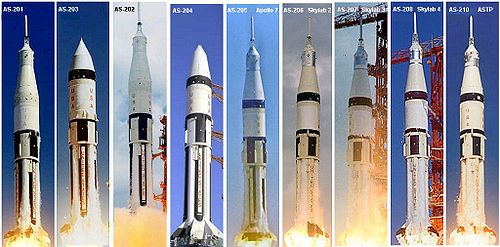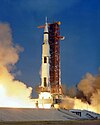Saturn IB: Difference between revisions
mNo edit summary |
|||
| Line 111: | Line 111: | ||
{{main|S-IB}} |
{{main|S-IB}} |
||
[[Image:Saturn IB 1st stage.jpg|left|thumb|300px|Diagram of the S-IB first stage of the Saturn IB rocket]] |
[[Image:Saturn IB 1st stage.jpg|left|thumb|300px|Diagram of the S-IB first stage of the Saturn IB rocket]] |
||
The S-IB stage is an eight engine booster for Earth orbital missions. It is composed of nine propellant tanks, eight fins, a thrust structure assembly, eight [[H-1 (rocket engine)|H-1]] [[rocket engine]]s, and many other components. The propellant containers consist of eight [[PGM-11 Redstone|Redstone]] tanks (Four holding [[LOX]] and four holding [[RP-1]].) clustered around a [[PGM-19 Jupiter|Jupiter rocket]] tank, which contains [[LOX]]. The four outboard engines were mounted on [[Gimbal|gimbals]], allowing them to be steered to control the rocket. |
The S-IB stage is an eight engine booster for Earth orbital missions. (It was irreverently nicknamed, "Cluster's Last Stand.") It is composed of nine propellant tanks, eight fins, a thrust structure assembly, eight [[H-1 (rocket engine)|H-1]] [[rocket engine]]s, and many other components. The propellant containers consist of eight [[PGM-11 Redstone|Redstone]] tanks (Four holding [[LOX]] and four holding [[RP-1]].) clustered around a [[PGM-19 Jupiter|Jupiter rocket]] tank, which contains [[LOX]]. The four outboard engines were mounted on [[Gimbal|gimbals]], allowing them to be steered to control the rocket. |
||
*Height: 83.6 ft (25.5 m) |
*Height: 83.6 ft (25.5 m) |
||
Revision as of 12:39, 11 October 2010
 The Saturn IB rocket for the AS-202 mission | |
| Function | Manned LEO launch vehicle |
|---|---|
| Manufacturer | Chrysler (S-IB) Douglas (S-IVB) |
| Country of origin | United States |
| Size | |
| Height | 68 m (224 ft) |
| Diameter | 6.6 m (21.7 ft) |
| Mass | 581,844 kg (1,282,850 lb) |
| Stages | 2 |
| Capacity | |
| Payload to LEO | 20,800 kg (46,000 lb) |
| Launch history | |
| Status | Retired |
| Launch sites | LC-37 & LC-34, Cape Canaveral LC-39B, Kennedy Space Center |
| Total launches | 9 |
| Success(es) | 9 |
| Failure(s) | 0 |
| First flight | February 26, 1966 |
| Last flight | July 15, 1975 |
| Type of passengers/cargo | Manned Apollo CSM |
| First stage - S-IB | |
| Engines | 8 * H-1 |
| Thrust | 7,100,000 N (1,600,000 lbf) |
| Burn time | ~150 seconds |
| Propellant | RP-1/LOX |
| Second stage S-IVB | |
| Engines | 1 Rocketdyne J-2 |
| Thrust | 1,000,000 N (225,000 lbf) |
| Burn time | ~475 seconds |
| Propellant | LH2/LOX |
The Saturn IB (alternatively known as the Uprated Saturn I) was an uprated version of the Saturn I rocket, which replaced its S-IV second stage with the much more powerful S-IVB. Unlike the earlier Saturn I, the IB had enough throw weight to launch either the Apollo Command/Service Module (partially fueled), or the Lunar Module into Earth orbit. This made it invaluable for testing the Apollo spacecraft while the larger Saturn V needed to send it to the Moon was still being developed.
Specifications
| Parameter | S-IB - 1st Stage | S-IVB - 2nd Stage | Instrument Unit | Spacecraft-to-LM Adapter |
|---|---|---|---|---|
| Height (m) | 25.5 | 17.8 | 0.9 | 8.5 |
| Diameter (m) | 6.6 | 6.6 | 6.6 | 6.6 tapers to 3.9 |
| Gross mass (kg) | 458,107 | 119,920 | 1,980 | 1,837 |
| Empty mass (kg) | 45,267 | 13,311 | N/A | N/A |
| Engines | Eight - H-1 | One - J-2 | N/A | N/A |
| Thrust (kN) | 7,582 | 1,020 | N/A | N/A |
| Isp (s) | 288 | 421 | N/A | N/A |
| Isp (kN·s/kg) | 2.82 | 4.13 | N/A | N/A |
| Burn duration (s) | 150 | 470 | N/A | N/A |
| Propellant | LOX/RP-1 | LOX/LH2 | N/A | N/A |
S-IB stage

The S-IB stage is an eight engine booster for Earth orbital missions. (It was irreverently nicknamed, "Cluster's Last Stand.") It is composed of nine propellant tanks, eight fins, a thrust structure assembly, eight H-1 rocket engines, and many other components. The propellant containers consist of eight Redstone tanks (Four holding LOX and four holding RP-1.) clustered around a Jupiter rocket tank, which contains LOX. The four outboard engines were mounted on gimbals, allowing them to be steered to control the rocket.
- Height: 83.6 ft (25.5 m)
- Diameter: 21.7 ft (6.6 m)
- Number of fins: 8
- Finspan: 18 ft (5.5 m)
- Engines: 8 H-1
- Thrust: 1,600,000 lbf (7.1 MN)
- Fuel: RP-1 (Refined kerosene) 41,000 US gal (155 m³)
- Oxidizer: Liquid oxygen (LOX) 66,000 US gal (250 m³)
- Burn time: 2.5 min
- Burnout altitude: 42 miles (68 km)
S-IVB stage

The S-IVB-200 stage is similar to the S-IVB-500 third stage used on the Saturn V, with the exception of the interstage adapter, smaller auxiliary propulsion control modules, and lack of on-orbit engine restart capability. It is powered by a single J-2 engine. The propellant and oxidizer tanks shared a common bulkhead, which saved about ten tons of weight and reduced vehicle length over ten feet.
- Height: 58.4 ft (17.8 m)
- Diameter: 21.7 ft (6.6 m)
- Number of fins: 0
- Engines: 1 J-2
- Thrust: 225,000 lbf (1.0 MN)
- Fuel: Liquid hydrogen (LH2) 64,000 US gal (242 m³)
- Oxidizer: Liquid oxygen (LOX) 20,000 US gal (76 m³)
- Burn time: approx. 7 min
- Burnout altitude (for Saturn IB): orbit
Launch sequence events
| Launch Event | Time (s) | Altitude (km) | Range (km) |
|---|---|---|---|
| Ignition Command | -3.02 | . | . |
| First Motion | -0.19 | . | . |
| Liftoff | 0.00 | . | . |
| Initiate Pitch Maneuver | 10.0 | . | . |
| Initiate Roll Maneuver | 10.0 | . | . |
| End Roll Maneuver | 38.0 | . | . |
| Mach One | 62.18 | 7.63 | . |
| Max Q | 75.5 | 12.16 | . |
| Freeze Tilt | 134.40 | . | . |
| Inboard Engine Cutoff | 140.65 | . | . |
| Outboard Engine Cutoff | 144.32 | . | . |
| Ullage Rockets Ignition | 145.37 | . | . |
| S-IB / S-IVB Separation | 145.59 | . | . |
| S-IVB Ignition | 146.97 | . | . |
| Ullage Rocket Burnout | 148.33 | . | . |
| Ullage Rocket Jettison | 156.58 | . | . |
| Jettison LES | 163.28 | . | . |
| Start Pitch Over | 613.95 | . | . |
| S-IVB Cutoff | 616.76 | . | . |
| Orbit Insertion | 626.76 | . | . |
| Start S/C Sep Sequence | 663.11 | . | . |
| Spacecraft Separation | 728.31 | . | . |
Saturn IB vehicles and launches
The original Saturn IBs for Apollo were launched from LC-34 and LC-37, Cape Canaveral Air Force Station.
The Saturn IB was later used for manned Skylab flights, and the Apollo-Soyuz Test Project. This final production run did not have the alternating black and white tanks on the first stage that were hallmarks of the earlier runs. These launches were made from LC-39B, Kennedy Space Center, using a "milkstool" apparatus to hold the rocket up at a height to reach the Mobile Launcher Platform's crew access arm.


| Serial Number | Mission | Spacecraft Mass (kg) | Launch Date | Notes | ||
|---|---|---|---|---|---|---|
| SA-201 | AS-201 | 20,820 | February 26, 1966 | Unmanned suborbital test of Block I Command/Service Module (CSM) | ||
| SA-203 | AS-203 | None | July 5, 1966 | Unmanned test of unburned LH2 behavior in orbit to support S-IVB-500 restart design | ||
| SA-202 | AS-202 | 25,810 | August 25, 1966 | Unmanned suborbital test of Block I CSM | ||
| SA-204 | Apollo 1 | 20,412 | Was to be first manned orbital test of Block I CSM. Cabin fire killed astronauts and damaged CM during dress rehearsal for planned February 21, 1967 launch | |||
| SA-204 | Apollo 5 | 14,360 | January 22, 1968 | Unmanned orbital test of Lunar Module, used Apollo 1 launch vehicle | ||
| SA-205 | Apollo 7 | 16,520 | October 11, 1968 | Manned orbital test of Block II CSM | ||
| SA-206 | Skylab 2 | 19,979 | May 25, 1973 | Block II CSM ferried first crew to Skylab orbital workshop | ||
| SA-207 | Skylab 3 | 20,121 | July 28, 1973 | Block II CSM ferried second crew to Skylab orbital workshop | ||
| SA-208 | AS-208 | Standby Skylab 3 rescue CSM-119; not needed | ||||
| SA-208 | Skylab 4 | 20,847 | November 16, 1973 | Block II CSM ferried third crew to Skylab orbital workshop | ||
| SA-209 | AS-209 | Standby Skylab 4 and later Apollo-Soyuz rescue CSM-119; not needed. Currently on display in the KSC rocket garden | ||||
| SA-209 | Skylab 5 | Planned CSM mission to lift Skylab workshop's orbit to endure until Space Shuttle ready to fly; cancelled. | ||||
| SA-210 | ASTP | 16,780 | July 15, 1975 | Apollo CSM with special docking adapter module, rendezvoused with Soyuz 19. Last Saturn IB flight. | ||
| SA-211 | Unused | |||||
| SA-212 | Unused. First stage scrapped.[1] S-IVB stage converted to Skylab space station. | |||||
| SA-213 | Only first stage built. Unused and scrapped.[1] | |||||
| SA-214 | Only first stage built. Unused and scrapped.[1] | |||||
For earlier launches of vehicles in the Saturn I series, see the list in the Saturn I article.
Saturn 1B rockets on display

Currently there are three locations where Saturn 1B vehicles (or parts thereof) are on display:
- SA-209 is on display at the Kennedy Space Center Visitor Complex, with the Apollo Facilities Verification Vehicle. Due to severe corrosion, the first stage engines and Service Module were replaced with fabricated duplicates in 1993-1994.
- The SA-211 first stage is on display with the S-IVB-S "Battleship" static test stage stacked in a launch ready condition at the Alabama Welcome Center on I-65 in Ardmore, AL.
- The SA-211 S-IVB stage was converted to a Skylab mockup and is on display at the U.S. Space and Rocket Center in Huntsville, AL.
References
- ^ a b c "Saturn 1B History". Retrieved 2009-11-01.
External links
- http://www.apollosaturn.com/
- http://www.spaceline.org/rocketsum/saturn-Ib.html
- NASA Marshall Spaceflight Center, Template:PDF, 30 September 1972
- Template:PDF

